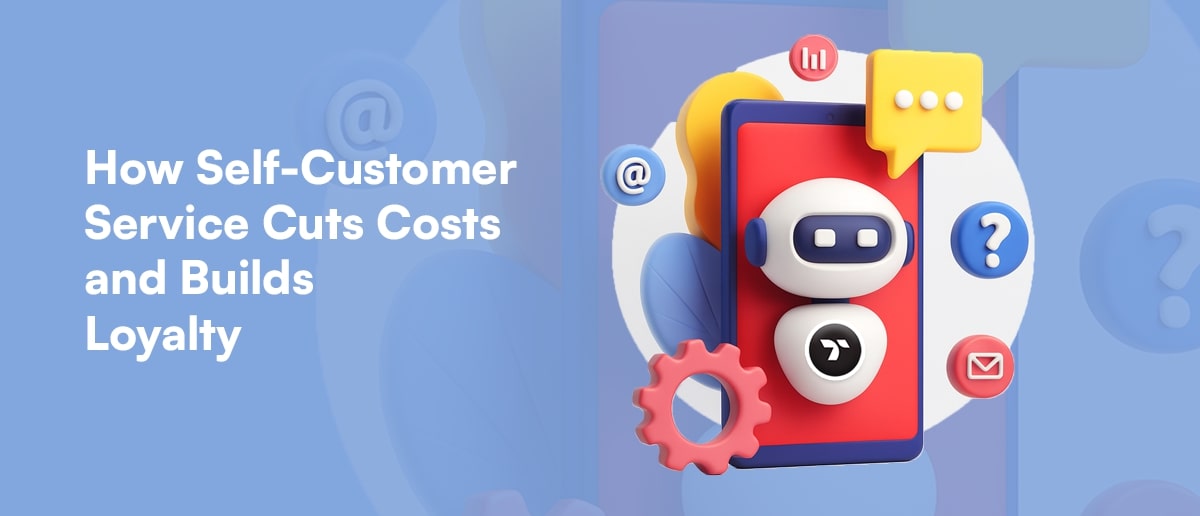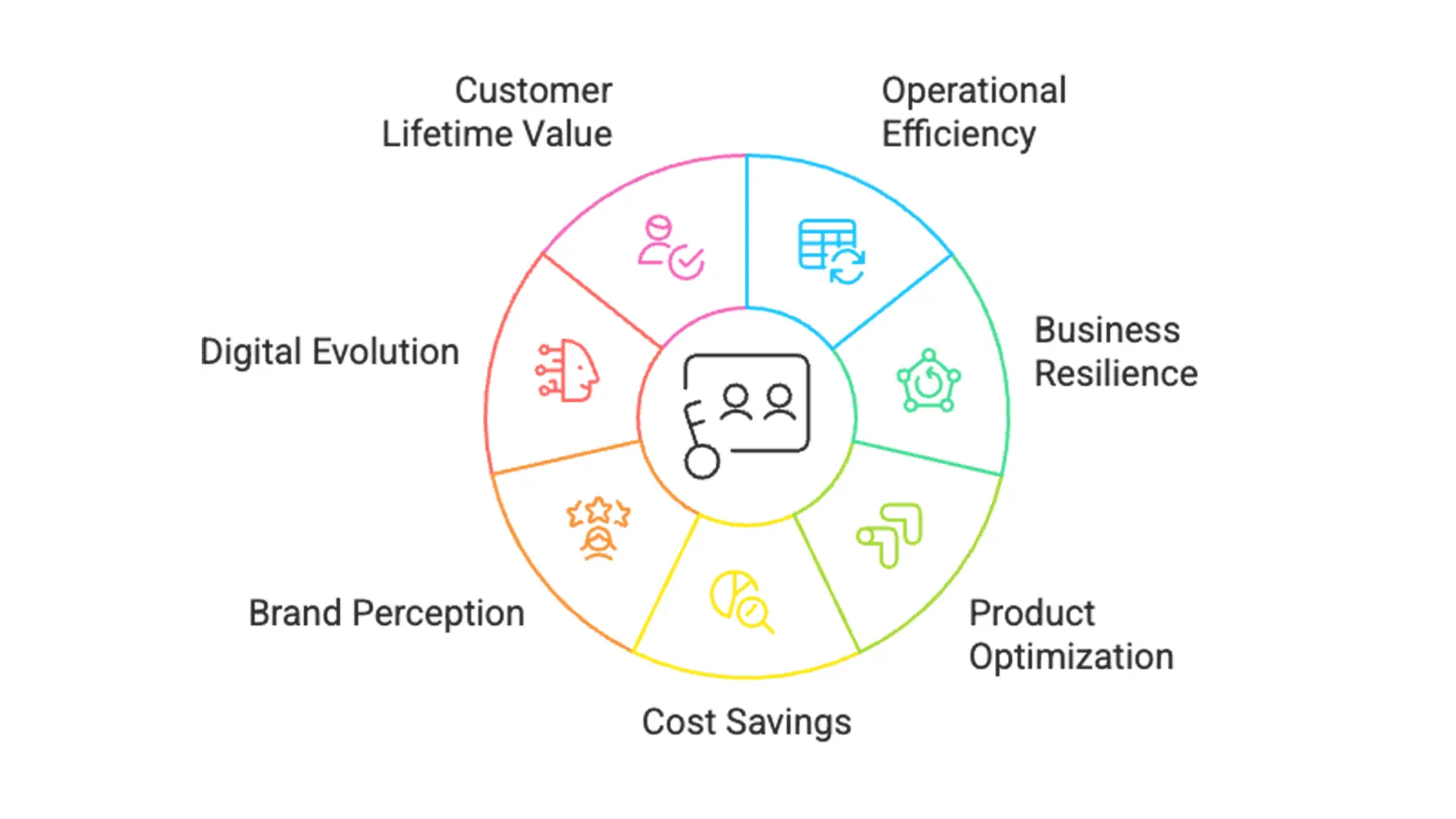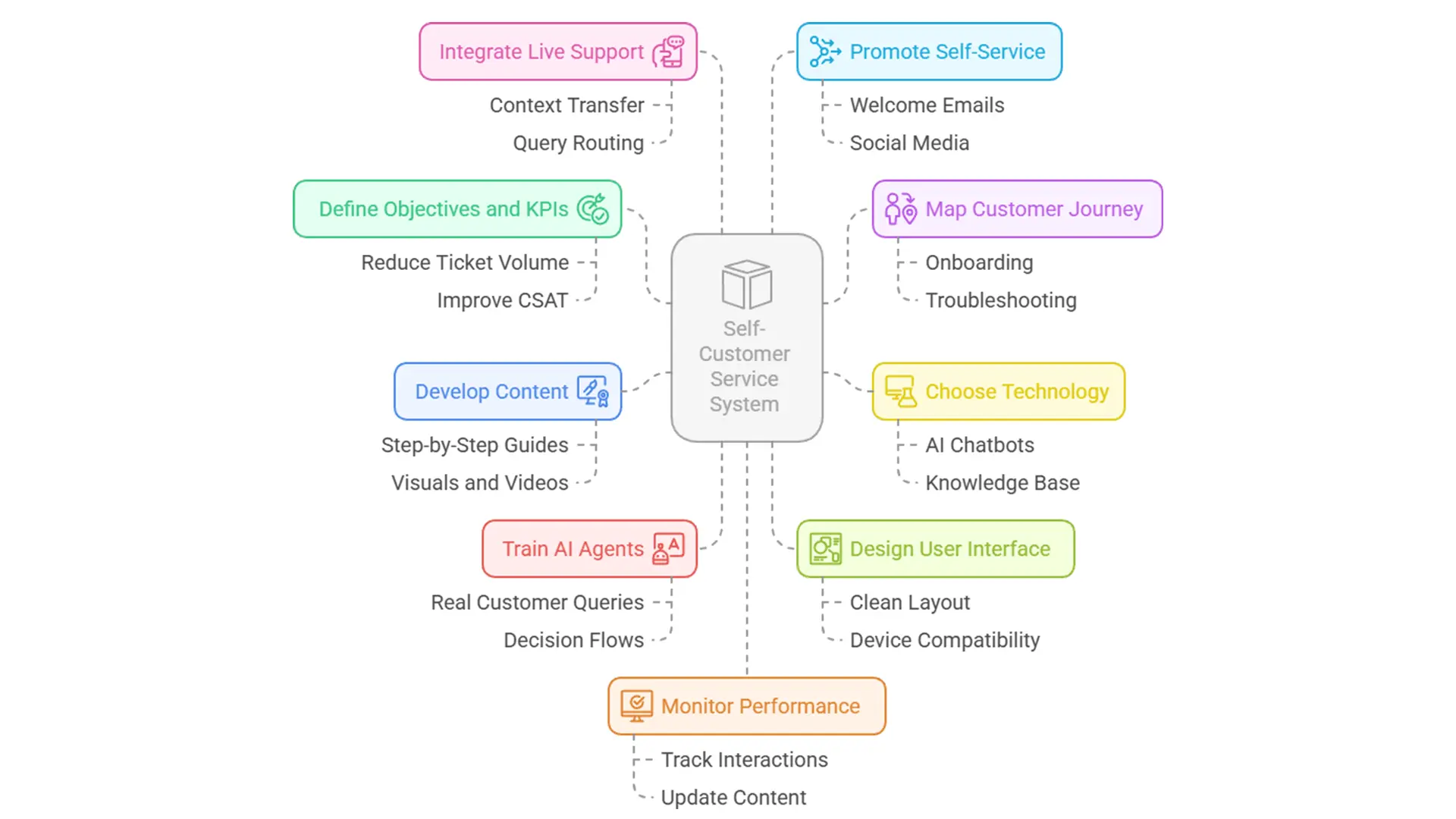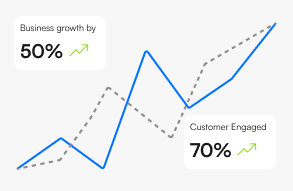How Self-Customer Service Cuts Costs and Builds Loyalty in 2026

Preetam Das
October 23, 2025
10 min

Table of Contents
Connecting with customers where they are and solving their problems is a golden opportunity for any business. And self-customer service is the golden ticket that helps businesses solve customer problems instantly while reducing the burden on your support teams.
According to Harvard Business Review, 81% of customers attempt to resolve issues themselves before reaching out to a live representative.
Take Joe; it’s midnight, and he faces an issue with a product. Instead of reaching for his phone to call the service team or wait for the morning to get the problem sorted out, he visits the company website, interacts with the support chatbot, and that’s it, he solves the problem.
And Joe is not alone; 73% of customers today prefer using the company website.
In fact, 40% would rather use the website than talk directly to a human, highlighting a growing shift toward self-guided support. But, why do people prefer self-customer service?
There’s something deeper behind it; it’s about control, almost like a psychological win. They expect things to be in control, even if it means doing it themselves.
So what’s the takeaway, and what should you actually do about it?
Websites are not just information or product listings. It’s the most critical customer service touchpoint. It should be designed not just for selling, but as a proactive problem-solving hub anticipating what customers need before they even ask.
That is why self-customer service is so important today.
What is Self-Customer Service
Self-customer service is a support approach that enables customers to solve problems and find answers on their own without needing to interact with a support agent. The goal is to reduce the need for live support by giving customers quick, easy access to what they need, whenever they need it.
It includes tools like FAQs, help centers, chatbots, customer portals, and in-product guides. With self-service, customers don’t have to wait in a queue; they get instant answers. This not only lowers support costs but also improves customer experience with 24/7 availability, reduces ticket volume, and helps build a stronger, more engaged customer community.
Benefits of Self-Customer Service

Self-customer service doesn’t just impact the support side of a business; it plays a critical role in how a company grows, competes, and delivers value at scale.
Giving customers the tools to solve problems on their own terms puts control in their hands while helping businesses meet people exactly where they are. Here’s how self-customer service drives long-term, strategic value across the organization:
Operational Efficiency at Scale
As a company scales and its customer base grows, so does the demand for additional support agents, training, and resources, driving up costs and reducing operational efficiency. Self-customer service eliminates this bottleneck.
It can handle thousands of interactions daily at virtually no incremental cost, allowing businesses to scale support effortlessly. With tools like Thinkstack for building chatbots and AI agents, companies can expand service capacity while staying lean, agile, and cost-efficient.
Business Resilience and Agility
Customer needs can shift overnight, driven by product updates, outages, high-traffic campaigns, or broader market changes. Relying solely on human support in these moments often leads to slowdowns, long wait times, and missed opportunities.
Self-customer service gives businesses the agility, keeps your support system steady under pressure, and ensures customers always get timely, relevant help, no matter what’s happening behind the scenes.
Product and UX Optimization Through Customer Insight
Every customer interaction generates valuable data that helps businesses build a stronger, more accurate ideal customer persona, enabling more precise targeting and messaging.
Platforms like Thinkstack automate this process by collecting and analyzing interaction data in real time. Their AI-powered chatbots, easily integrated into websites or social media, provide insights through sentiment analysis, trend tracking, and lead capture, including the source of each lead. These insights give businesses a clearer picture of how to serve their customers better.
Cost Savings Without Compromising Quality
Live customer support interactions are expensive, especially as businesses scale. Hiring more agents, training them, and maintaining quality across teams can quickly inflate costs.
Self-customer service significantly reduces support costs by automating high-volume, repetitive tasks without compromising the quality of customer experience. Customers get faster answers, support teams stay focused on complex issues, and budgets can be redirected toward innovation and growth.
Stronger Brand Perception and Digital Maturity
Customers no longer judge brands only by their products; they also evaluate how easy and efficient the overall experience feels. A seamless self-customer service system signals digital maturity, trustworthiness, operational excellence, and respect for the customer’s time. This improved perception directly impacts customer retention and boosts organic brand advocacy through word-of-mouth.
Enabler of Digital Evolution and AI Integration
Self-service systems lay the groundwork for smarter, more scalable operations by structuring content, streamlining workflows, and capturing real-time data. This foundation allows companies to confidently implement technologies such as:
- AI-powered chatbots and virtual assistants
- Predictive support models
- Voice and conversational interfaces
- Smart routing and automated resolution flows
Increased Customer Lifetime Value (CLV)
When customers consistently get fast, accurate support through self-service, they stick around longer, engage more deeply, and are more likely to make repeat purchases. This directly increases customer lifetime value.
By surfacing personalized content, relevant offers, and timely education through self-service touchpoints, businesses create moments that drive conversion and retention.
How to Implement a Self-Customer Service System

Implementing a self-customer service system requires a structured, strategic approach that aligns with your business goals, customer expectations, and operational capabilities. It isn’t just about plugging in a chatbot or launching an FAQ page.
Define Clear Objectives and KPIs
What do you want to achieve? Identify that first. Is it to reduce ticket volume, improve CSAT, lower costs, or accelerate onboarding? Defining and measuring the right metrics will help you analyze, set direction, gain clarity, and guide your decisions over time.
- Self-service adoption rate
- Case deflection rate
- Average resolution time
- Escalation rate
- Customer satisfaction (CSAT/NPS)
Map the Customer Journey
Identify key support moments across the customer journey from onboarding and purchase to usage, troubleshooting, and renewals. Prioritize which touchpoints to enable with self-service first, and tailor the content and tools to actual customer needs. Understand where customers typically need help, and make sure there’s a smooth transition between self-service and live support.
Choose the Right Technology
This is the most important step; a successful self-service strategy often combines several solutions. Select tools that match your business size, complexity, and customer expectations. Look for tools with open integrations so your self-service system can plug into CRMs, help desks, and analytics platforms for a seamless backend.
- AI chatbots and virtual agents.
- Knowledge base software.
- Generative AI tools.
- Customer portals with account-level support access.
- Search-optimized FAQ systems.
- Mobile-optimized support experiences.
- Analytics dashboards for performance tracking.
There are many tools available, like Tidio, Chatbase, Botpress, and Thinkstack, that leverage LLMs like ChatGPT to help you build AI chatbots, internal AI agents, and AI sales agents.
Thinkstack lets you train and build AI agents and chatbots on your own data without any coding, and scale with your business.
Develop High-Quality Content
The quality of content behind any self-service system has a direct impact on its performance and ROI. A self-service system is only as good as the content powering it. Generative AI models like ChatGPT-powered systems can accelerate content creation, especially for repetitive or template-based topics. Invest time in:
- Writing clear, step-by-step guides.
- Using visuals and video to explain complex processes.
- Structuring content for easy scanning and mobile use.
- Focus first on the small set of recurring questions that drive the bulk of your support tickets.
Build and Train Your AI Agents
Your AI chatbots and virtual assistants need to be more than just responsive; they should be brand-aligned, helpful, and capable. That’s why training is non-negotiable:
- Training on real customer queries and ticket data
- Scripting decision flows for common support paths
- Defining smart fallback and escalation protocols
- Enabling actions like resetting passwords, updating info, or modifying orders
Thinkstack makes this easy by letting you train AI agents on your own data, simply by uploading documents in various formats. You have the flexibility to customize tone of voice, response style, and even presentation to match your branding.
Design an Intuitive User Interface
A well-designed self-service portal should make finding answers effortless. The layout needs to be clean and easy to navigate, ensuring users can move through it without friction. It should work seamlessly across all devices, whether someone’s on a desktop or using their phone on the go.
Integrate with Live Support and Escalation Paths
Ensure smooth handoff to human agents when necessary. Automatically pass context and history to agents so customers don’t have to repeat themselves. Route complex queries based on category, urgency, or customer type. The goal is to avoid customer frustration by making it easy to switch channels without starting over.
Promote Self-Service to Customers
Customers need to know your self-service system exists for it to create real impact. Make it visible, accessible, and easy to interact with. Promote it through welcome emails, in-app messages, chat widget pop-ups, help center CTAs, social media, and support email signatures.
Set clear expectations, show what customers can do on their own, and highlight the benefits like speed, convenience, and 24/7 availability. The more visible and trusted it is, the more customers will use it.
Monitor Performance and Continuously Improve
Regularly track how customers interact with your self-service system and collect feedback to spot opportunities for improvement. Keep content fresh by updating outdated or underperforming articles, and adding new topics based on search queries and missed deflections.
Continuously train your AI agents to improve accuracy and better handle evolving customer needs.
Share insights across departments, marketing, product, and customer success so everyone benefits from real customer behavior data. And always make sure your self-service strategy aligns with broader business goals like customer retention, cost efficiency, NPS, or market expansion.
Conclusion
Today, how you support your customers is just as important as what you sell. Self-customer service is a core business capability. Customers today expect instant, effortless solutions, and businesses that meet this expectation gain more than just efficiency; they build trust, reduce costs, and create better experiences at scale.
With the right strategy, tools, and ongoing measurement, businesses can implement self-customer service successfully.
AI agent builders like Thinkstack generate real-time analytics dashboards that show exactly how customers interact with your bots. From sentiment analysis and trend tracking to lead capture, you get the insights you need to refine the experience, improve performance, and measure ROI.
Build your own self-customer service system in minutes
Get started for freeFrequently Asked Questions (FAQs)

Grow Your Business with AI Agents
- Automate tasks
- Engage customers 24/7
- Boost conversions